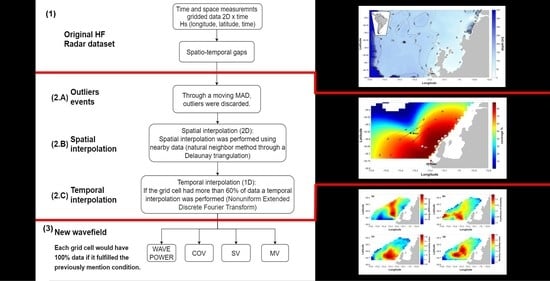A Preliminary Study of Wave Energy Resource Using an HF Marine Radar, Application to an Eastern Southern Pacific Location: Advantages and Opportunities
Abstract
:1. Introduction
2. Materials and Methods
2.1. Study Area and Data
2.1.1. Study Area
2.1.2. HF Marine Radar
2.2. Methodology
2.2.1. Data Processing
2.2.2. Wave Potential
2.3. Layout
3. Results
4. Discussion and Conclusions
Author Contributions
Funding
Data Availability Statement
Acknowledgments
Conflicts of Interest
References
- Cornett, A. A Global Wave Energy Resource Assessment. In Proceedings of the Eighteenth International Offshore and Polar Conference, Vancouver, BC, Canada, 6–11 July 2008. [Google Scholar]
- Arinaga, R.A.; Cheung, K.F. Atlas of global wave energy from 10 years of reanalysis and hindcast data. Renew. Energy 2012, 39, 49–64. [Google Scholar] [CrossRef]
- Reeve, D.E.; Chen, Y.; Pan, S.; Magar, V.; Simmonds, D.J.; Zacharioudaki, A. An investigation of the impacts of climate change on wave energy generation: The Wave Hub, Cornwall, UK. Renew. Energy 2011, 36, 2404–2413. [Google Scholar] [CrossRef] [Green Version]
- Gunn, K.; Stock-Williams, C. Quantifying the global wave power resource. Renew. Energy 2012, 44, 296–304. [Google Scholar] [CrossRef]
- Mork, G.; Barstow, S.; Kabuth, A.; Pontes, M.T. Assessing the Global Wave Energy Potential. In Proceedings of the 29th International Conference on Ocean, Offsh-ore and Arctic Engineering, Shanghai, China, 6–11 June 2010; Volume 3, pp. 447–454. [Google Scholar]
- European Commission. Technology Information: Ocean Energy; European Commission: Brussels, Belgium, 2014. [Google Scholar]
- IRENA. Renewable Capacity Statistics 2017; International Renewable Energy Agency (IRENA): Abu Dhabi, UAE, 2017. [Google Scholar]
- Europe Ocean Energy. 2030 Ocean Energy Vision; Europe Ocean Energy: Brussels, Belgium, 2019. [Google Scholar]
- Trowbridge, J.; Weller, R.; Kelley, D.; Dever, E.; Plueddemann, A.; Barth, J.A.; Kawka, O. The Ocean Observatories Initiative. Front. Mar. Sci. 2019, 6. [Google Scholar] [CrossRef]
- Lillesand, T.; Kiefer, R.; Chipman, J. Remote Sensing and Image Interpretation, 7th ed.; Wiley: Hoboken, NJ, USA, 2015. [Google Scholar]
- Ribal, A.; Young, I.R. 33 years of globally calibrated wave height and wind speed data based on altimeter observations. Sci. Data 2019, 6. [Google Scholar] [CrossRef] [Green Version]
- Gurgel, K.W.; Antonischiki, G. Remote Sensing of Surface Currents and Waves by the Hf Radar Wera. In Proceedings of the International Conference on Electronic Engineering in Oceanography, Southampton, UK, 23–25 June 1997. [Google Scholar]
- Essen, H.H.; Gurgel, K.W.; Schlick, T. Measurement of ocean surface waves by HF radars using a direction finding receive antenna. In Proceedings of the IGARSS 2000. IEEE 2000 International Geoscience and Remote Sensing Symposium. Taking the Pulse of the Planet: The Role of Remote Sensing in Managing the Environment. Proceedings (Cat. No.00CH37120), Honolulu, HI, USA, 24–28 July 2000. [Google Scholar]
- Lipa, B.; Barrick, D.; Broug, J.; Nyden, B. HF Radar Detection of Tsunamis. J. Oceanogr. 2006, 62, 705–716. [Google Scholar] [CrossRef]
- Lopez, G.; Conley, D.C. Comparison of HF Radar Fields of Directional Wave Spectra Against In Situ Measurements at Multiple Locations. J. Mar. Sci. Eng. 2019, 7, 271. [Google Scholar] [CrossRef] [Green Version]
- Saviano, S.; Kalampokis, A.; Zambianchi, E.; Uttieri, M. A year-long assessment of wave measurements retrieved from an HF radar network in the Gulf of Naples (Tyrrhenian Sea, Western Mediterranean Sea). J. Oper. Oceanogr. 2019, 12, 1–15. [Google Scholar] [CrossRef]
- Helzel, T.; Lopez, O.; Wyatt, L.R. Ocean Radar for the Planning and Operational Phase of Off-Shore Renewable Energy System; IEEE: Piscataway, NJ, USA, 2011. [Google Scholar]
- Patel, R.P.; Nagababu, G.; Kumar, S.V.A.; Seemanth, M.; Kachhwaha, S.S. Wave resource assessment and wave energy exploitation along the Indian coast. Ocean Eng. 2020, 217, 107834. [Google Scholar] [CrossRef]
- Wyatt, L.R. An evaluation of wave parameters measured using a single HF radar system. Can. J. Remote Sens. 2002, 28, 205–218. [Google Scholar] [CrossRef]
- Wyatt, L.R. Significant waveheight measurement with h.f. radar. Int. J. Remote Sens. 1988, 9, 1087–1095. [Google Scholar] [CrossRef]
- Heron, M.L.; Atwater, D.P. Temporal and spatial resolution of HF ocean radars. Ocean Sci. J. 2013, 48, 99–103. [Google Scholar] [CrossRef]
- Fujii, S.; Heron, M.L.; Kim, K.; Lai, J.-W.; Lee, S.-H.; Wu, X.; Wu, X.; Wyatt, L.R.; Yang, W.-C. An overview of developments and applications of oceanographic radar networks in Asia and Oceania countries. Ocean Sci. J. 2013, 48, 69–97. [Google Scholar] [CrossRef]
- Roarty, H.; Cook, T.; Hazard, L.; George, D.; Harlan, J.; Cosoli, S.; Wyatt, L.; Alvarez Fanjul, E.; Terrill, E.; Otero, M.; et al. The Global High Frequency Radar Network. Front. Mar. Sci. 2019, 6. [Google Scholar] [CrossRef]
- Young, I.R. Seasonal Variability Of The Global Ocean Wind And Wave Climate. Int. J. Climatol. 1999, 19, 931–950. [Google Scholar] [CrossRef]
- Aguirre, C.; Rutllant, J.A.; Falvey, M. Wind waves climatology of the Southeast Pacific Ocean. Int. J. Climatol. 2017, 37, 4288–4301. [Google Scholar] [CrossRef]
- Lucero, F.; Catalán, P.A.; Ossandón, Á.; Beyá, J.; Puelma, A.; Zamorano, L. Wave energy assessment in the central-south coast of Chile. Renew. Energy 2017, 114, 120–131. [Google Scholar] [CrossRef]
- Leys, C.; Ley, C.; Klein, O.; Bernard, P.; Licata, L. Detecting outliers: Do not use standard deviation around the mean, use absolute deviation around the median. J. Exp. Soc. Psychol. 2013, 49, 764–766. [Google Scholar] [CrossRef] [Green Version]
- Amidror, I. Scattered data interpolation methods for electronic imaging systems: A survey. J. Electron. Imaging 2002, 11. [Google Scholar] [CrossRef]
- Liepins, V. An algorithm for evaluating a discrete Fourier transform for incomplete data. Autom. Control Comput. Sci. 1996, 30, 20–29. [Google Scholar]
- Liepins, V. Extended Fourier analysis of signals. arXiv 2013, arXiv:1303.2033. [Google Scholar]
- Bingölbali, B.; Jafali, H.; Akpınar, A.; Bekiroğlu, S. Wave energy potential and variability for the south west coasts of the Black Sea: The WEB-based wave energy atlas. Renew. Energy 2020, 154, 136–150. [Google Scholar] [CrossRef]
- Holthuijsen, L.H. Waves in Oceanic and Coastal Waters; Cambridge University Press: Cambridge, UK, 2007; Volume 1. [Google Scholar]
- Soares, C.G. (Ed.) Advances in Renewable Energies Offshore; Taylor & Francis: London, UK, 2018. [Google Scholar]
- Ingram, D.M.; Smith, G.; Bittencourt Ferreira, C.; Smith, H. Protocols for the Equitable Assessment of Marine Energy Converters; The Institute for Energy Systems: Edinburgh, UK, 2011. [Google Scholar]
- Beyá, J.; Álvarez, M.; Gallardo, A.; Hidalgo, H.; Aguirre, C.; Valdivia, J.; Parra, C.; Méndez, L.; Contreras, F.; Winckler, P.; et al. Atlas de Oleaje de Chile; Escuela de Ingeniería Civil Oceánica—Universidad de Valparaiso: Valparaiso, Chile, 2016. [Google Scholar]
- Reguero, B.G.; Losada, I.J.; Méndez, F.J. A global wave power resource and its seasonal, interannual and long-term variability. Appl. Energy 2015, 148, 366–380. [Google Scholar] [CrossRef]
- Silva, D.; Martinho, P.; Guedes Soares, C. Wave energy distribution along the Portuguese continental coast based on a thirty three years hindcast. Renew. Energy 2018, 127, 1064–1075. [Google Scholar] [CrossRef]
- Alizadeh, M.J.; Alinejad-Tabrizi, T.; Kavianpour, M.R.; Shamshirband, S. Projection of spatiotemporal variability of wave power in the Persian Gulf by the end of 21st century: GCM and CORDEX ensemble. J. Clean. Prod. 2020, 256, 120400. [Google Scholar] [CrossRef]
- de Energía, C.C. Energía 2050, Política Energética de Chile; Ministerio de Energía: Santiago, Chile, 2017. [Google Scholar]
- Comisión Nacional de Energía. Anuario Estadístico de Energía; Ministerio de Energía: Santiago, Chile, 2018; pp. 1–162. [Google Scholar]
- Villavicencio, P. Chile Cuenta Con Nuevo Centro de Investigación, Pionero en Energía Marina. Available online: https://www.elciudadano.com/ciencia-tecnologia/centro-de-energia-marina/06/18/ (accessed on 10 September 2020).
- MERIC. Ministro de Energía Inaugura Pionero Centro de Investigación en Energía Marina. Available online: https://www.meric.cl/en/ministro-de-energia-inaugura-pionero-centro-de-investigacion-en-energia-marina-2/ (accessed on 10 September 2020).
- Mediavilla, D.G.; Figueroa, D. Assessment, sources and predictability of the swell wave power arriving to Chile. Renew. Energy 2017, 114, 108–119. [Google Scholar] [CrossRef]
- Mediavilla, D.G.; Sepúlveda, H.H. Nearshore assessment of wave energy resources in central Chile (2009–2010). Renew. Energy 2016, 90, 136–144. [Google Scholar] [CrossRef]
- Mazzaretto, O.M.; Lucero, F.; Besio, G.; Cienfuegos, R. Perspectives for harnessing the energetic persistent high swells reaching the coast of Chile. Renew. Energy 2020, 159, 494–505. [Google Scholar] [CrossRef]
- Monárdez, P.; Acuña, H.; Scott, D. Evaluation of the Potential of Wave Energy in Chile. In Proceedings of the ASME 2008 27th International Conference on Offshore Mechanics and Arctic Engineering, Estoril, Portugal, 15–20 June 2008; Volume 6, pp. 801–809. [Google Scholar]
- Wyatt, L.R. Wave and Tidal Power measurement using HF radar. IMEJ 2018, 1. [Google Scholar] [CrossRef]
- Wyatt, L.R. High frequency radar applications in coastal monitoring, planning and engineering. Aust. J. Civ. Eng. 2014, 12, 1–15. [Google Scholar] [CrossRef]
- Beyá, J.; Álvarez, M.; Gallardo, A.; Hidalgo, H.; Winckler, P. Generation and validation of the Chilean Wave Atlas database. Ocean Model. 2017, 116, 16–32. [Google Scholar] [CrossRef]
- Sandberg, A.; Klementsen, E.; Muller, G.; de Andres, A.; Maillet, J. Critical Factors Influencing Viability of Wave Energy Converters in Off-Grid Luxury Resorts and Small Utilities. Sustainability 2016, 8, 1274. [Google Scholar] [CrossRef] [Green Version]
- Astariz, S.; Iglesias, G. The economics of wave energy: A review. Renew. Sustain. Energy Rev. 2015, 45, 397–408. [Google Scholar] [CrossRef]
- Amrutha, M.M.; Sanil Kumar, V. Spatial and temporal variations of wave energy in the nearshore waters of the central west coast of India. Ann. Geophys. 2016, 34, 1197–1208. [Google Scholar] [CrossRef] [Green Version]
- Comisión Nacional de Energía. Consumo Eléctrico Anual por Comuna y Tipo de Cliente; Energía Abierta; Comisión Nacional de Energía: Santiago, Chile, 2019. [Google Scholar]
- Aderinto, T.; Li, H. Review on Power Performance and Efficiency of Wave Energy Converters. Energies 2019, 12, 4329. [Google Scholar] [CrossRef] [Green Version]
- Maldonado, C. Stochastic Modelling of Owc Device and Power Production; Pontificia Universidad Catolica De Chile: Santiago, Chile, 2017. [Google Scholar]
- Comisión Nacional de Energía. Factor de Emisión, Promedio Anual; Energía Abierta; Comisión Nacional de Energía: Santiago, Chile, 2019. [Google Scholar]
- Astariz, S.; Iglesias, G. Co-located wind and wave energy farms: Uniformly distributed arrays. Energy 2016, 113, 497–508. [Google Scholar] [CrossRef] [Green Version]
- Cienfuegos, R.; Villagran, M.; Aguilera, J.C.; Catalán, P.; Castelle, B.; Almar, R. Video monitoring and field measurements of a rapidly evolving coastal system: The river mouth and sand spit of the Mataquito River in Chile. J. Coast. Res. 2014, 70, 639–644. [Google Scholar] [CrossRef]
- Cang, Y.; He, H.; Qiao, Y. Measuring the Wave Height Based on Binocular Cameras. Sensors 2019, 19, 1338. [Google Scholar] [CrossRef] [Green Version]
- Valentini, N.; Balouin, Y. Assessment of a Smartphone-Based Camera System for Coastal Image Segmentation and Sargassum monitoring. J. Mar. Sci. Eng. 2020, 8, 23. [Google Scholar] [CrossRef] [Green Version]
- Hauser, D.; Tourain, C.; Lachiver, J.M. CFOSAT: A New Mission in Orbit to Observe Simultaneously Wind and Waves at the Ocean Surface. Space Res. Today 2019, 206, 15–21. [Google Scholar] [CrossRef]
- Aouf, L.; Hauser, D.; Dalphinet, A.; Giordani, H. SWOT-Waves: For the Improvement of Operational Wave Forecasting; NASA: Washington, DC, USA, 2020.
- Peral, E.; Rodríguez, E.; Esteban-Fernández, D. Impact of Surface Waves on SWOT’s Projected Ocean Accuracy. Remote Sens. 2015, 7, 14509–14529. [Google Scholar] [CrossRef] [Green Version]
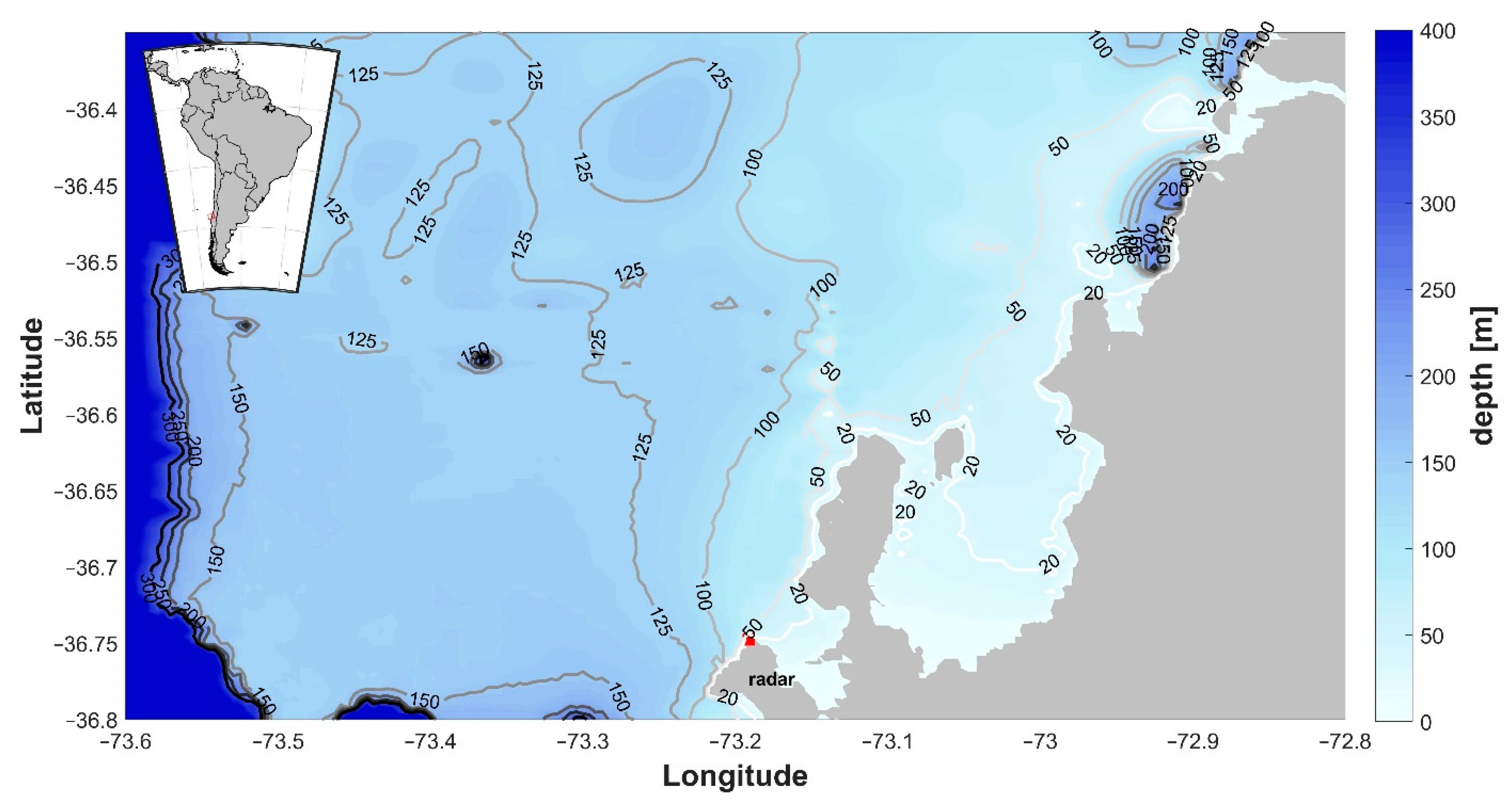

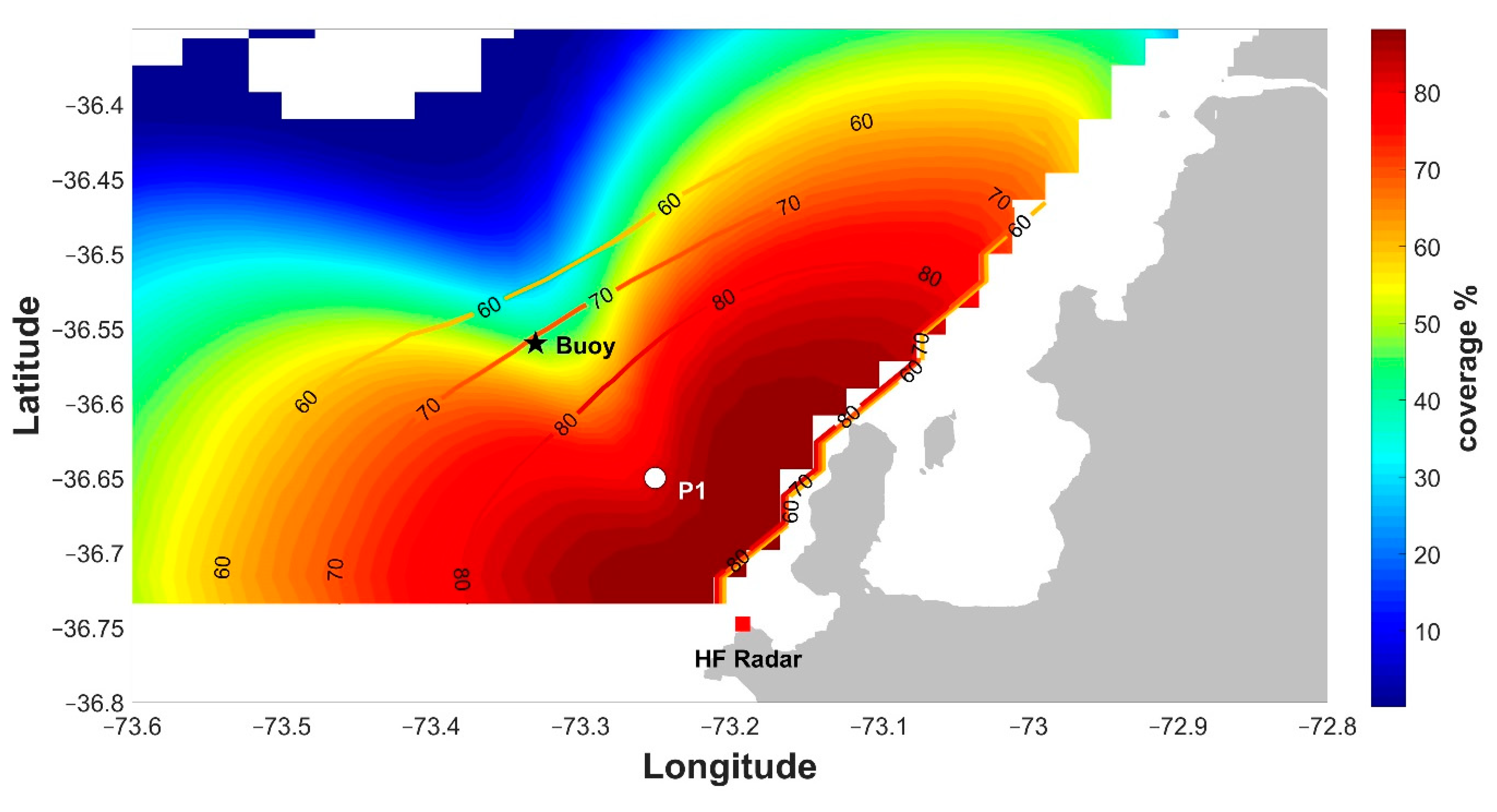
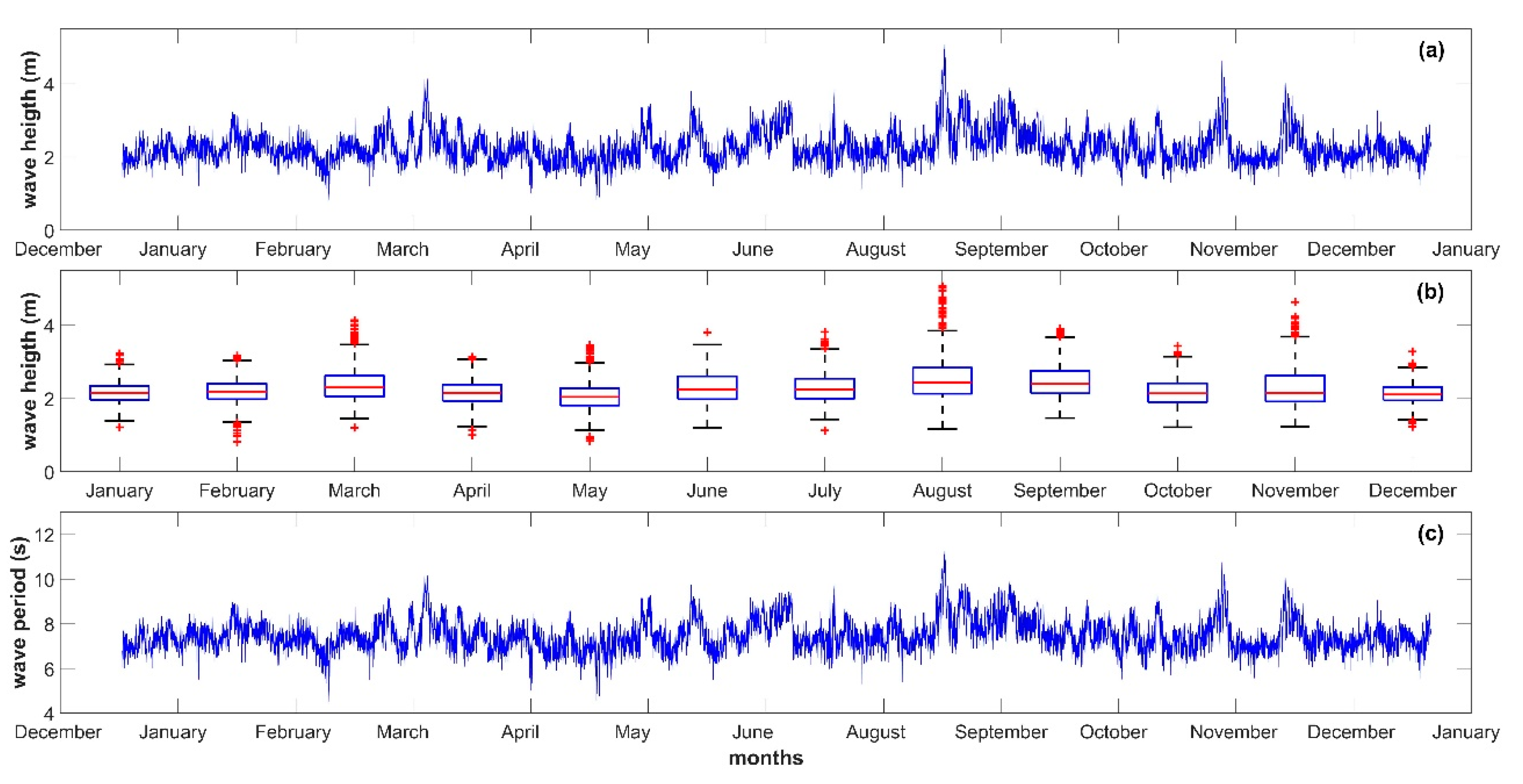
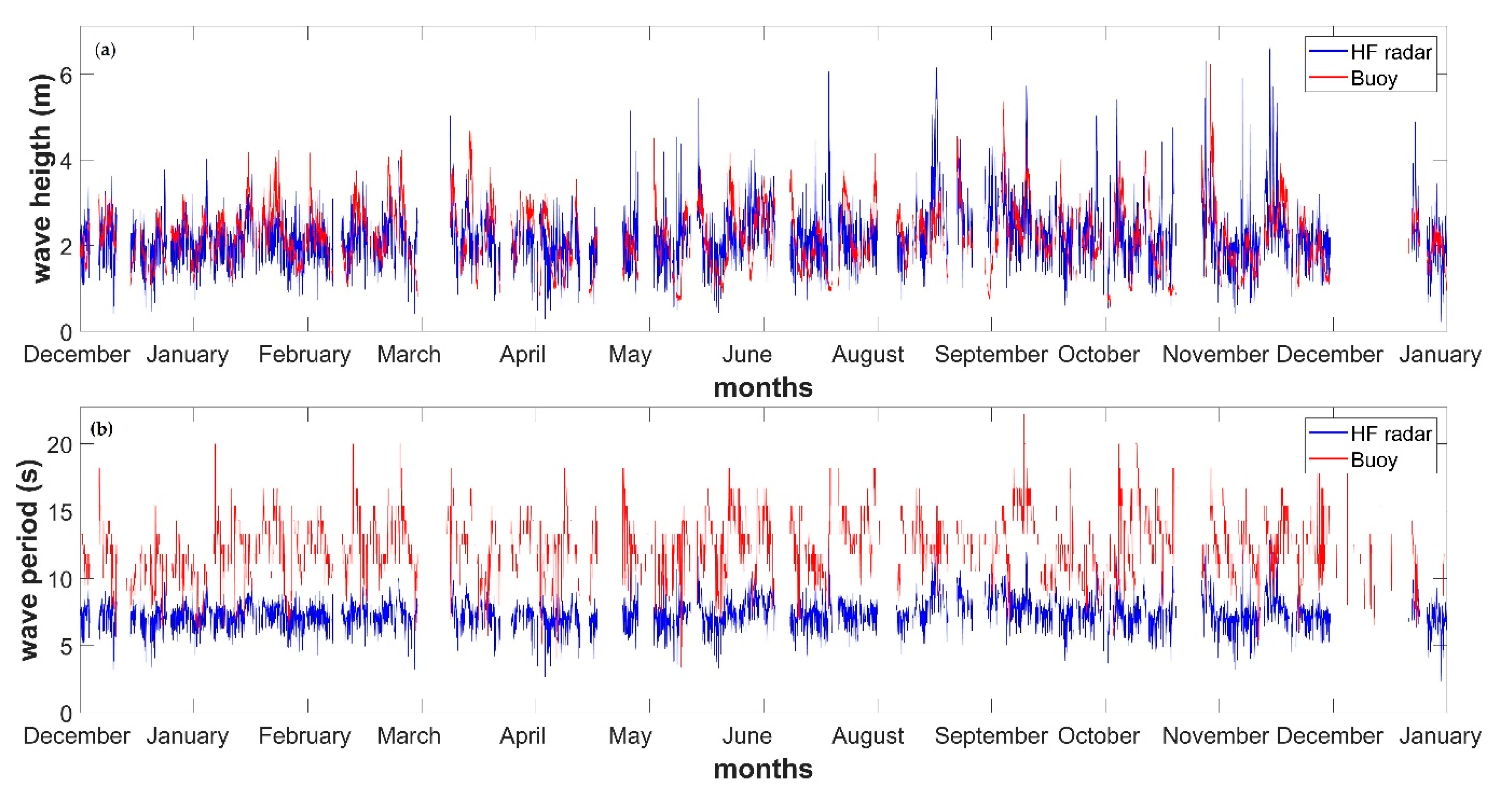
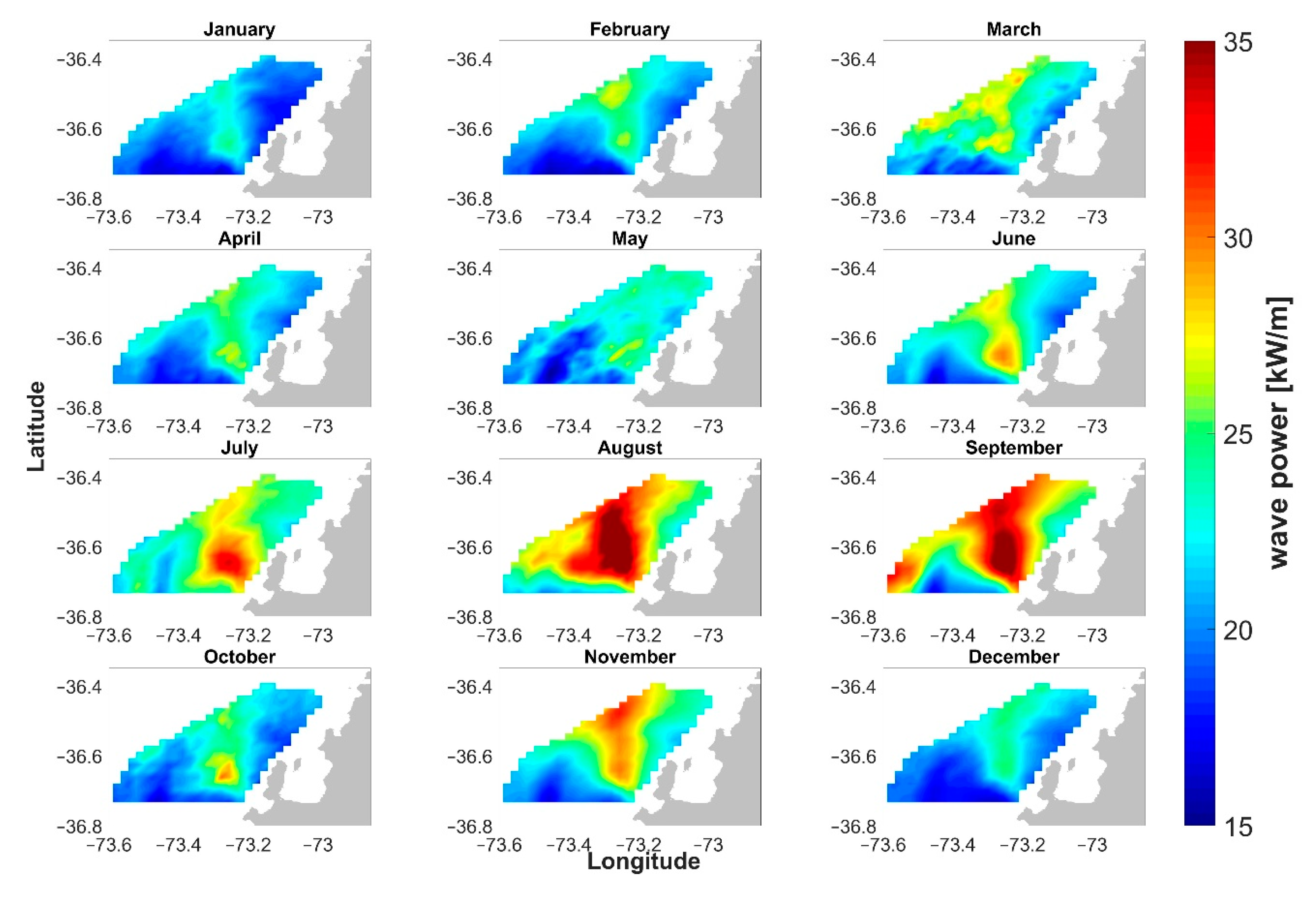
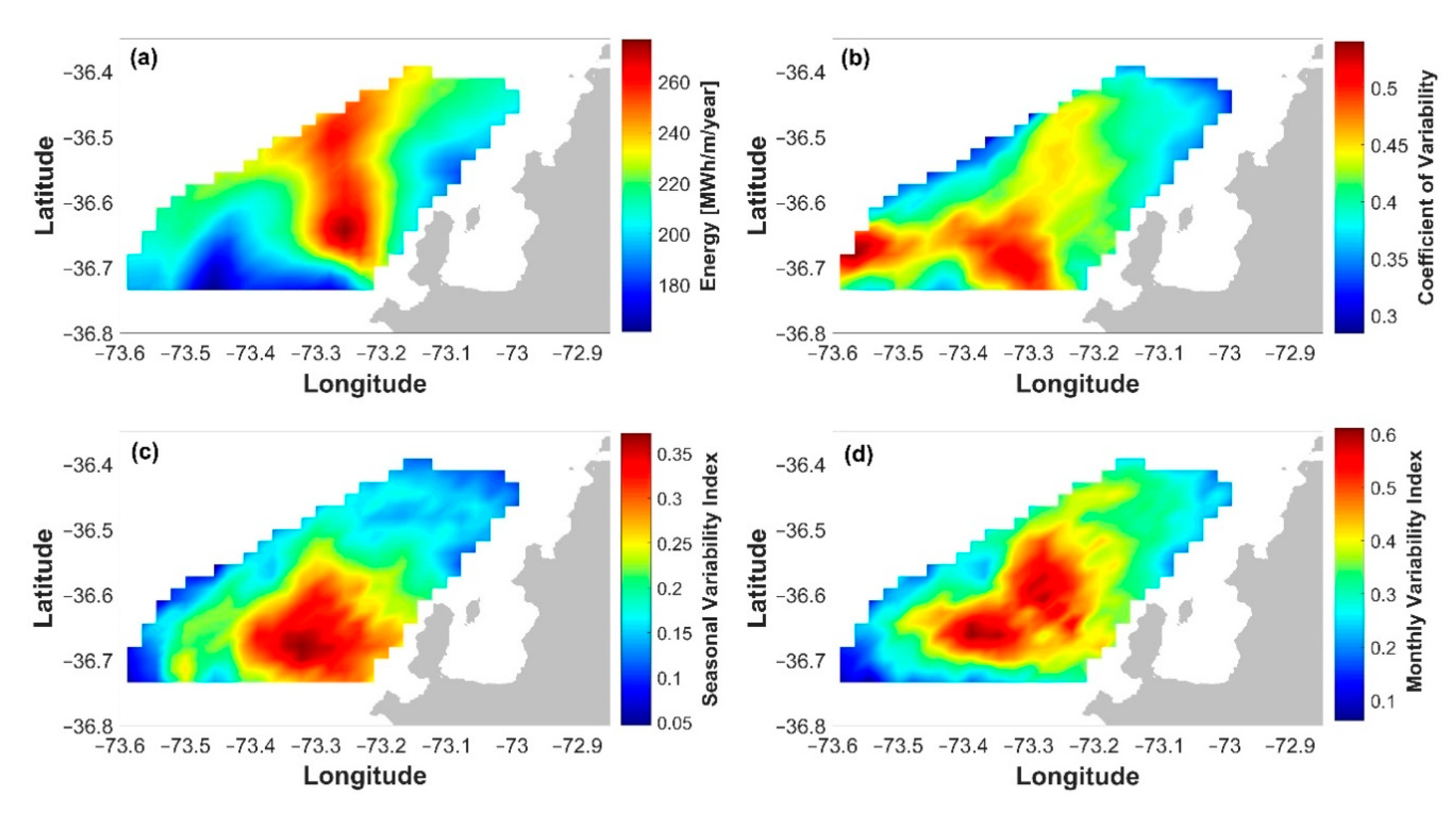
Publisher’s Note: MDPI stays neutral with regard to jurisdictional claims in published maps and institutional affiliations. |
© 2021 by the authors. Licensee MDPI, Basel, Switzerland. This article is an open access article distributed under the terms and conditions of the Creative Commons Attribution (CC BY) license (http://creativecommons.org/licenses/by/4.0/).
Share and Cite
Mundaca-Moraga, V.; Abarca-del-Rio, R.; Figueroa, D.; Morales, J. A Preliminary Study of Wave Energy Resource Using an HF Marine Radar, Application to an Eastern Southern Pacific Location: Advantages and Opportunities. Remote Sens. 2021, 13, 203. https://doi.org/10.3390/rs13020203
Mundaca-Moraga V, Abarca-del-Rio R, Figueroa D, Morales J. A Preliminary Study of Wave Energy Resource Using an HF Marine Radar, Application to an Eastern Southern Pacific Location: Advantages and Opportunities. Remote Sensing. 2021; 13(2):203. https://doi.org/10.3390/rs13020203
Chicago/Turabian StyleMundaca-Moraga, Valeria, Rodrigo Abarca-del-Rio, Dante Figueroa, and James Morales. 2021. "A Preliminary Study of Wave Energy Resource Using an HF Marine Radar, Application to an Eastern Southern Pacific Location: Advantages and Opportunities" Remote Sensing 13, no. 2: 203. https://doi.org/10.3390/rs13020203




